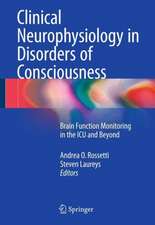Pulmonary Function Indices in Critical Care Patients
Autor Josef X. Brunner, Gunther Wolffen Limba Engleză Paperback – 29 feb 1988
Preț: 711.32 lei
Preț vechi: 748.76 lei
-5% Nou
Puncte Express: 1067
Preț estimativ în valută:
136.10€ • 142.12$ • 112.39£
136.10€ • 142.12$ • 112.39£
Carte tipărită la comandă
Livrare economică 15-29 aprilie
Preluare comenzi: 021 569.72.76
Specificații
ISBN-13: 9783540184324
ISBN-10: 3540184325
Pagini: 188
Ilustrații: XIII, 171 p. 18 illus.
Dimensiuni: 170 x 242 x 10 mm
Greutate: 0.31 kg
Editura: Springer Berlin, Heidelberg
Colecția Springer
Locul publicării:Berlin, Heidelberg, Germany
ISBN-10: 3540184325
Pagini: 188
Ilustrații: XIII, 171 p. 18 illus.
Dimensiuni: 170 x 242 x 10 mm
Greutate: 0.31 kg
Editura: Springer Berlin, Heidelberg
Colecția Springer
Locul publicării:Berlin, Heidelberg, Germany
Public țintă
ResearchCuprins
1. Evaluation of Pulmonary Function in the Intensive Care Patient.- 1.1. The Clinically Important Pulmonary Function Index.- 1.2. What Clinicians Expect of Transducers and Data Processing.- 1.3. A Measuring System for Clinical Research.- 2. Derivation of the Pulmonary Function Indices.- 2.1. Introduction.- 2.2. Breathing Mechanics.- 2.3. Lung Volume and Intrapulmonary Gas Mixing.- 2.4. Transpulmonary Gas Transport: Exchange of O2 and CO2.- 3. Assessment of Pulmonary Function Indices.- 3.1. Sensors.- 3.2. Data Processing.- 3.3. Testing the Measuring System.- 3.4. Use of the Measuring System in the Intensive Care Unit.- 3.5. Sensitivity of the Indices in the Presence of Acute Pathological Changes in the Lungs: Case Studies.- 4. Application I: Standard Values Dring Mechanical Ventilation After Cardiac Surgery.- 4.1. Patients and Examination.- 4.2. The Ventilation.- 4.3. Breathing Mechanics.- 4.4. Accessible Pulmonary Volume.- 4.5. Washout Efficiency and Moment Analysis.- 4.6. CO2 Production and O2 Consumption.- 4.7. Conventional Indices for CO2 Exchange.- 4.8. Specific Indices for CO2 Exchange.- 4.9. Cardiac Output.- 4.10. Correlations.- 5. Application II: A Study on Optimizing Mechanical Ventilation.- 5.1. Problem.- 5.2. Studies by Other Authors.- 5.3. Hypotheses.- 5.4. Patients and Methods.- 5.5. Results and Discussion.- 5.6. Summarizing Discussion and Conclusions.- 6. Application III: A Study on Intermittent Mandatory Ventilation (IMV).- 6.1. Patients and Methods.- 6.2. Results.- 6.3. Discussion.- 7. Appendices.- 7.1. On the Morphology of the Lungs.- 7.2. Technical Principles of Mechanical Ventilation.- 7.3. Measuring the Pleural Pressure with an Esophageal Balloon.- 7.4. Transport Equation for Convection and Diffusion.- 7.5. Relationship Between Dead Space andV?A/Q? Scatter.- 7.6. Viscosity of Gas Mixture.- 7.7. Determination and Dependencies of the Delay Time Between Flow Sensor and Mass Spectrometer.- 7.8. List of Formulas.- 7.9. Result-Tables.- References.









